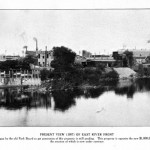Civic Center Historic District (City Beautiful)
NRHP 1988 Criteria A & C
Both sides of river from Center Street Dam to Scott Street Dam
City Beautiful advocates believed creating a beautiful city would inspire its inhabitants to moral and civic virtue would bring their city cultural parity with European counterparts, and a more inviting city center would encourage people to work and spend money in the urban areas. The first major use was by Daniel Burnham for the 1901 Plan for Washington, DC.
Other towns to follow the City Beautiful Plan – Chicago, Detroit, Columbus, Cleveland, Montreal, Denver, Madison, Pittsburg and parts of San Francisco.
The Beaux-Arts style popular due to the World’s Columbian Exposition in 1893 held in Chicago. The fair set American taste in architecture for the next 15 years.
Daniel Hudson Burnham was indisputably the “Father of the City Beautiful.” As director of works of the World’s Columbian Exposition (1893), he effectively launched the movement that 15 years later would reach its apogee in his epochal Plan of Chicago (1909). Burnham’s importance as an architect and planner lay chiefly in his ability to direct and stimulate the design efforts of others. His own credo captured the essence of his life and work: “Make no little plans; they have no magic to stir men’s blood. … Make big plans … remembering that a noble, logical diagram once recorded will never die, but long after we are gone will be a living thing asserting itself with ever growing consistency.” In his various architectural and planning pursuits, Burnham choreographed large efforts indeed.
The Des Moines Commercial Club’s Civic Improvement Committee evolved into the Town Planning Committee in 1916. The Committee’s goals were to provide riverfront improvements, expansion of public grounds around the Capitol, to develop a system of boulevards and expansion of the park system.
The movement’s ideas were in full swing by 1919; the banks of the river had been cleaned up and a number of public structures were built facing the riverfront.
This served as the primary axis through Des Moines, with the streets and their bridges viewed as the secondary axis.
The first building to be built along these “civic” lines was the Union Depot in 1899.
Public buildings constructed on the east and west banks of the Des Moines River in an area known as the Civic Center:
- Des Moines Public Library (1900-1903),
- Coliseum (no longer standing, built 1908-1910 burnt 1948)
- Post Office (1909-1910),
- Municipal Building (1909-1910)
- Municipal Court and Public Safety Building (1918-1920)
- U.S. Courthouse (1928)
- Armory and World War Memorial Building (1934-1935)
These buildings are distinguished by their river front location and by their harmonious design, style, scale, use, and materials. Planned at the beginning of the twentieth century following the principles and aesthetic ideals of the City Beautiful Movement, the buildings were intended to blend, to work as a planned unit, rather than to stand apart as individual monuments to one architect’s design. The civic buildings on both sides of the river join the independent cities of East Des Moines and Des Moines.
